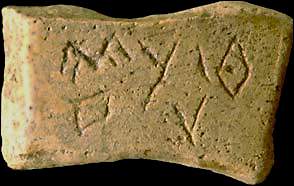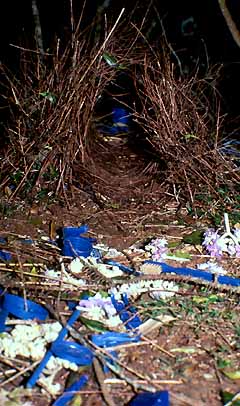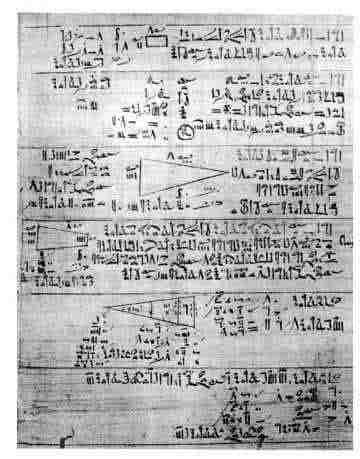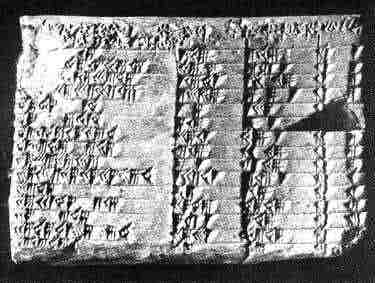ATKINSON FACULTY OF LIBERAL AND PROFESSIONAL STUDIES
SCHOOL OF ANALYTIC STUDIES & INFORMATION TECHNOLOGY
S C I E N C E A N D T E C H N O L O G Y S T U D I E S
STS 3700B 6.0 HISTORY OF COMPUTING AND INFORMATION TECHNOLOGY
Lecture 1: From Prehistory to History: Egypt, Babylonia, India
| Prev | Next | Search | Syllabus | Selected References | Home |
| 0 | 1 | 2 | 3 | 4 | 5 | 6 | 7 | 8 | 9 | 10 | 11 | 12 | 13 | 14 | 15 | 16 | 17 | 18 | 19 | 20 | 21 | 22 |
Topics
-
In Computers and Computation. Readings from Scientific American (R F Fenichel & J Weizenbaum, eds., p 134. San Francisco 1971), the
editors write:
"Computation has always been viewed as a service to problem solving. The architectural monuments of the ancients and their extensive sea voyages testify to the successes of even the earliest reckoners. But in ancient times, even as today, computation raised problems at least as deep and as difficult as those it hoped to solve. Euclid's geometry served the builders of his time in many practical ways, but for Euclid himself it mainly raised problems of axiomatization and theorem proving. The earliest automatic computers—Babbage's analytic engine and the ENIAC [...]—were designed to help compute astronomical and ballistic tables, respectively. But man can not merely own tools, intellectual or otherwise, without soon seeing them as objects for study just like any other objects in his environment. Computers are, on the one hand, mathematical machines; on the other, they are machines capable of doing mathematics. It cannot be surprising, then, that they have stimulated mathematicians to think of both mathematics of and mathematics for computers."
That is why the history of computers is also the history of computing, of the need to compute, of the personal and social disposition to compute. That is also why the automation of computing must be viewed not only as a technological end, but also as the source of new fields of curiosity and knowledge. -
From Numbers to Numerals and From Numerals to Computation. This is the title of an article by D E Smith and J Ginsburg (reprinted
in The World of Mathematics, J R Newman ed., vol 1, p. 442. New York 1956), where the authors describe the (then) available evidence
concerning the transition from words, such as "two", to numerals, such as "2", and the development of the first computational techniques for
manipulating numerals. It is very hard to pinpoint when such transitions took place, precisely because only written language can record these events
with sufficient precision, and these events are the first instances of written language. Without entering any further into the intricacies of the
debate, we can rather safely say that writing first appeared, probably independently, in Mesopotamia, Egypt and a few other areas (e.g. Harappa,
in today's Pakistan) not much earlier than around 3500 BCE, and that the earliest clay tokens made their debut in the Middle East around 8000 BCE,
reflecting the development of agriculture. "Archaeological studies of the period show evidence of grain cultivation in fields surrounding villages,
the construction of communal silos for storing grain, and a rapid increase in population. In such a setting, individual farmers needed a reliable way
to keep track of their goods, especially the amount of grain stored in shared facilities. It seems they did it by maintaining stocks of baked-clay
tokens—one token for each item, different shapes for different types of items. A marble-sized clay sphere stood for a bushel of grain, a cylinder
for an animal, an egg-shaped token for a jar of oil. There were as many tokens, or counters, of a certain shape as there were of that item in the farmer's
store." [ From Counting to Writing ]

Earliest writing? Harappa, Punjab. About 3500 BCE
It is interesting to note the striking examples of decorative artifacts can be found in the elaborate constructions of birds such as the Satin Bowerbird or the Scrub Turkey. Are these comparable to the kind of human artifacts we are considering here?
Satin Bowerbird Ptilonorhycnhus Violaceus and His Blue-Littered Bower
[ © Copyright 2002 Don Roberson. Used with permission ]
Tokens are not writing yet, although they are symbolic representations of concrete objects. The fundamental breakthrough must have happened when it was realized that three stars, three cows, three children, etc.—or their token counterparts—all have something in common—the number three—and that therefore, at least for certain purposes, all these tokens could be replaced by a single sign, by the numeral 3. Or, to quote Bertrand Russell, "it must have required many ages to discover that a brace of pheasants and a couple of days were both instances of the number 2: the degree of abstraction involved is far from easy. And the discovery that 1 is a number must have been difficult." [ Bertrand Russell, Introduction to Mathematical Philosophy. 1916. Reprinted by Routledge 1993. p. 3 ] Let us then assume this stage has been reached, and focus on the development of ways of organizing and manipulating numerals. We will consider in some detail a few examples, but not before we say a few words about the two main systems of notation: the additive system and the positional system."In [the additive] system there is a distinct symbol for each kind of group made during the counting process, and this symbolis repeated as often as necessary to indicate how many of each group are needed. The Egyptian number system is the classical example of an additive system; however, most people are more familiar with the additive system used by the Romans." "In positional number systems, the counting groups are denoted entirely by the position of the symbol in the string of characters denoting the number. This means that it is usually necessary to have a zero symbol to show an empty group." [ M R Williams, History of Computing Technology (IEEE Computer Society Press 1997) ]
-
One of the finest instances of the level of computational sophistication achieved in the ancient world is offered by the Rhind papyrus (also called the
Ahmes papyrus), which was found in Egypt and dates from around 1650 BCE, although the scribe Ahmes states on the papyrus itself that his is
a transcription of the original, which is 200 years older.

The Rhind or Ahmes papyrus. Detail. About 1650 BCE
The Rhind papyrus measures 18 feet long by 13 inches wide, and is a collection of some eighty-five problems or exercises. Most of the problems are about fractions, simple equations, areas and volume. but a few are rather advanced for the times. Here is one: "A cylindrical granary of 9 diameter and height 6. What is the amount of grain that goes into it?" The solution requires first the calculation of the volume of the granary. We would write V = pi x (d/2)2 x h, where V is the volume sought, pi is 3.14..., d is the diameter, and h is the height of the granary. The formula used on the papyrus is instead V = ((8/9) x d)2 x h. If you perform the calculations, you can see that the Egyptians approximated pi with the value 3.16. Not bad…Another example is in the form of an equation: what is the value of a quantity such that, if you add added a quarter of it to it, you get 15? Try it... [ James R Newman, The Rhind Papyrus, in The World of Mathematics, J R Newman ed., vol 1, p. 170. New York 1956 ] [ An Overview of Egyptian Mathematics ]
-
The Plimpton 322 tablet, together with several other tablets from Babylonia, contain various examples of commercial transactions, as well as important geometrical
and arithmetical results.

The Plimpton 322 Tablet. Babylonia. Around 1800-1650 BCE
In particular, Plimpton 322 appears to be a table of numbers relating to Pythagoras's theorem—obviously discovered long before Pythagoras' times (about 569 BCE to about 475 BCE). In case you forgot, this theorem states that in a right-angled triangle the square of the length of hypothenuse is equal to the sum of the squares of the lengths of the sides. An explicit illustration of this theorem appears on another tablet, where one can read [ Pythagoras's Theorem in Babylonian Mathematics ] :"4 is the length and 5 the diagonal. What is the breadth ?
In other words, 52 = 32 + 42. Our notation is clearly much more concise, and lends itself to an algebraic generalization: c2 = a2 + b2, where c is the length of the hypothenuse, and a and b are the lengths of the sides of any right-angled triangle. We will return to this obvious but important point in the next lecture.
Its size is not known.
4 times 4 is 16.
5 times 5 is 25.
You take 16 from 25 and there remains 9.
What times what shall I take in order to get 9 ?
3 times 3 is 9.
3 is the breadth."
- We now turn, once again only very briefly, to Indian mathematics. The great French mathematician Pierre-Simon Laplace (1749-1827) wrote: "The ingenious method
of expressing every possible number using a set of ten symbols (each symbol having a place value and an absolute value) emerged in India. The idea seems so simple
nowadays that its significance and profound importance is no longer appreciated. Its simplicity lies in the way it facilitated calculation and placed arithmetic
foremost amongst useful inventions." [ quoted in An Overview of Indian Mathematics ]
Indeed Indian, or more correctly, Hindu civilization made enormous contributions to mathematics since at least the third millennium BCE. Even the graphic numerals we use today were first introduced in ancient India. Perhaps one of the greatest inventions made in India was the definition of zero. Here is the (commercial) definition offered by Brahmagupta (598-670):
"A debt minus zero is a debt.
Here fortune stands for any positive number and debt for any negative number. It is interesting to note that Brahmagupta tried also to define division by zero, but made a mistake (for any number n, including 0, n / 0 = 0, ) which continued for many centuries. [ Brahmagupta ]
A fortune minus zero is a fortune.
Zero minus zero is a zero.
A debt subtracted from zero is a fortune.
A fortune subtracted from zero is a debt.
The product of zero multiplied by a debt or fortune is zero.
The product of zero multiplied by zero is zero.
The product or quotient of two fortunes is one fortune.
The product or quotient of two debts is one fortune.
The product or quotient of a debt and a fortune is a debt.
The product or quotient of a fortune and a debt is a debt."
- In the next lecture we will finish this brief review and consider some of the contributions of the ancient Arabic and Mayan civilizations.
Readings, Resources and Questions
- Using the outline of this lecture as a guide, visit the Mathematics in Various Cultures website maintained by the School of Mathematics and Statistics at the University of St.Andrews, in Scotland.
- Check a recent article, Is Rock Art a Sign of Universal Language? reporting on the work of Emanuele Anati, one of the world's authorities on rock art, who, after comparing rock art from 160 countries on five continents, concluded that "comparative analysis shows that the earliest art is homogeneous all over the world, presenting the same logic structure, the same associations and symbolism. It is a mirror of the workings of Homo sapiens' mind."
- Chapter 1, In the Beginning..., of Michael R Williams, History of Computing Technology (IEEE Computer Society Press 1997) is also a very valuable resource.
- See also Florian Cajori, A History of Mathematical Notation, Dover Publications, New York, 1993 (reprinted from the original 1928, 1929 edition). "One of the most comprehesive and illuminating histories of mathematical notation ever written."
-
Read
 Ethnomathematics: A Rich Cultural Diversity.
Ethnomathematics: A Rich Cultural Diversity.
"Mathematics is absolutely integrated with Western civilization, which conquered and dominated the entire world. The only possibility of building up a planetary civilization depends on restoring the dignity of the losers and, together, winners and losers, moving into the new. [Ethnomathematics, then, is] a step towards peace."
- What are some of the problems faced by historians in establishing the origins of a discovery, of an invention, and generally of an idea?
-
Read
 The Dawn of New World Writing: Roots Traced Back to Glyphs of Mexico’s Olmec Civilization.
The Dawn of New World Writing: Roots Traced Back to Glyphs of Mexico’s Olmec Civilization.
- Browse Hossein Arsham's The Zero Saga &aamp; Confusions with Numbers, where you will find a large amount of historical information on zero, as well as about common mistaken ideas people have about ifts function and use.
Picture Credits: BBC News · University of St.Andrews · Creagrus
Last Modification Date: 11 April 2003